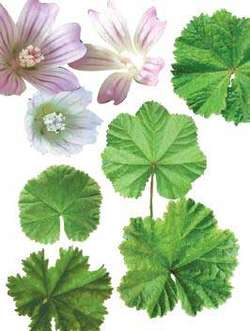mallow
mallow
mallow
Mallow
any one plant of the genus Malva of the family Malvaceae. It is an annual, biennial, or perennial grass with long-petiolate leaves. The flowers, which are axillary and in small groups, are purple, lilac, pink, or white. The calyx has an epicalyx. The ripened fruit breaks into monospermous segments. There are approximately 40 species, distributed in the temperate and, less commonly, subtropical zones of the northern hemisphere. About 20 species are found in the USSR, primarily near dwellings and in gardens and parks; they also grow as weeds among crops, in deserts, and sometimes in thickets and light forests.
High mallow (Malva sylvestris), dwarf mallow (M. neglecta), M. mauritiana, curled mallow (M. crispa) and other species contain carotene and vitamin C, and their leaves and young shoots are used for food. The flowers and leaves of high mallow, which are rich in mucilage, have been used as a tincture for many years to treat inflammations and irritations of the mucous membrane. A dye for wool and wine is obtained from the flowers. The species M. meluca yields a coarse fiber suitable for making string, twine, and hemp; its seeds contain a semidrying oil. Certain species of mallow yield nectar. Musk mallow (M. moschata), M. mauritiana, and M. alcea are cultivated as ornamentals. Some annual varieties that are used as animal feed are known as fodder mallows. Sometimes one species of hollyhock is called mallow.
T. V. EGOROVA
Mallow
several common wild plant species of the genus Malva. The best-known species are M. sylvestris, M. neglecta, and M. crispa; ornamental mallows include M. mauritiana and M.moschata.
